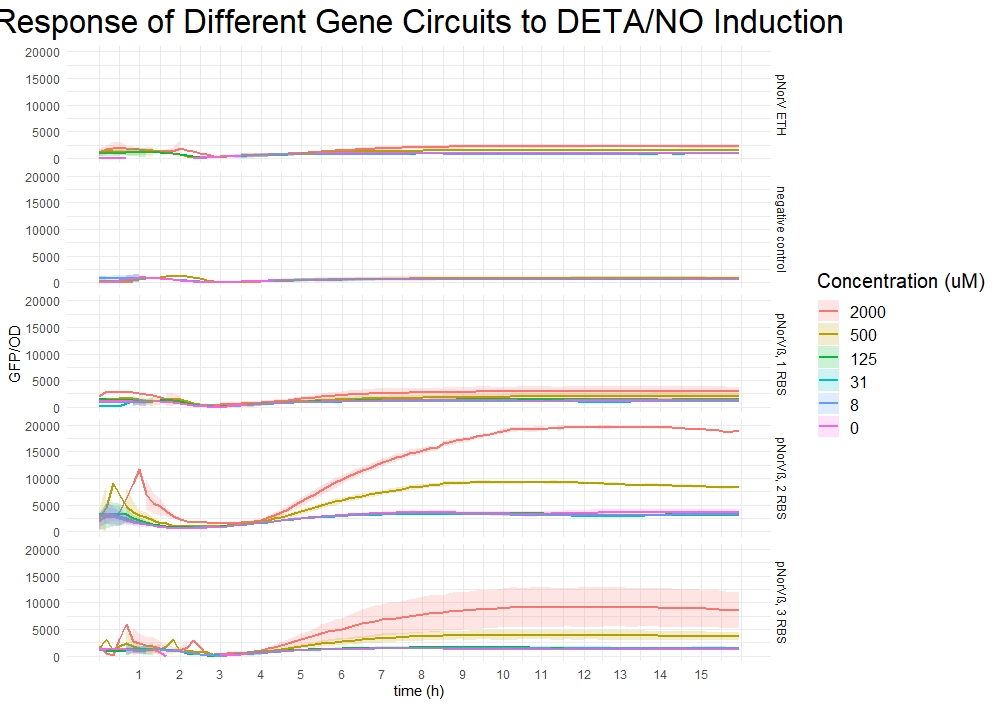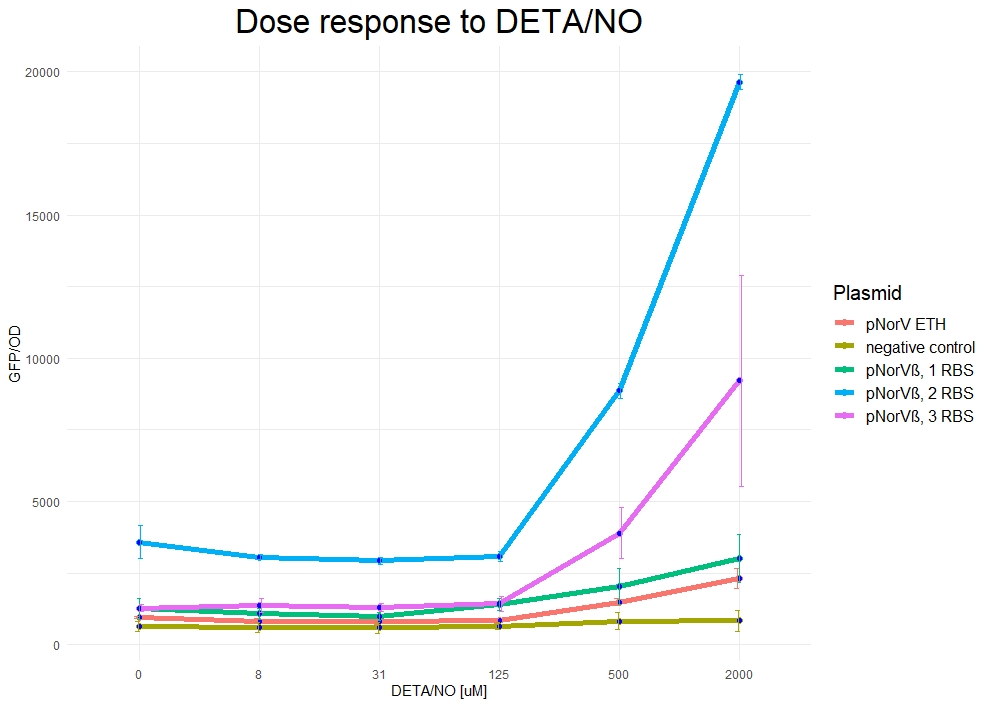Part:BBa_K4387004
Nitric Oxide Sensing Genetic Circuit with Promoter BBa_K2116002
Contents
Usage and Biology
This composite part consists of the ETH promoter pNorV [1][2], a superfolder GFP preceded by one strong ribosomal binding site (BBa_B0034), the NorR regulator, and a double forward terminator. We chose a high-copy backbone from Twist Bioscience for this part. We wanted to compare this ETH pNorV promoter to the pNorVβ promoter [3] and see which one was better suited for sensing nitric oxide at lower concentration ranges.
This construct was tested in the bacterial strain E.coli Nissle 1917.
Sequence and Features
- 10COMPATIBLE WITH RFC[10]
- 12COMPATIBLE WITH RFC[12]
- 21INCOMPATIBLE WITH RFC[21]Illegal XhoI site found at 742
- 23COMPATIBLE WITH RFC[23]
- 25COMPATIBLE WITH RFC[25]
- 1000COMPATIBLE WITH RFC[1000]
Characterization
Measuring parts with different approaches and comparing them to provide a more insightful and multilayered characterization is essential in Synthetic Biology. Here, we focused on two methods:
(i) time-lapse plate reader assays to measure the sensitivity of our circuit to NorR in a dynamic manner and under different concentrations of inducer; and
(ii) endpoint flow cytometry assays to measure the behavior of our circuits at the single-cell scale.
With the first assay, we uncovered essential kinetic information about the circuits on the populational level (every measurement is an average of the individual expression patterns in the sample). With the second assay, we delved deeper into the cell populations to characterize other essential properties of our system, such as expression noise and dose-dependent responses to different inducer concentrations.
We performed all analyses using in-house R scripts.
Time-Lapse Plate Reader Assay

To make our experiments reproducible during plate reader assays (PHERAstar FSX - λEx: 485 nm, λEm: 530 nm), we measured each sample for 16 hours at 37°C and constant orbital shaking, using three biological replicates (three individual colonies per circuit) and three technical replicates (three wells per biological replicate).
We performed the data analysis as follows:
- Subtracted blanks from raw data
- Normalize GFP by OD600
- Calculate technical means of GFP/OD600 normalized data
- Calculate the biological means of GFP/OD600 normalized data
- Calculate the biological standard deviation of GFP/OD600 normalized data
- When necessary, perform imputation. Usually, the first normalized measurements are noisy and unreliable as OD600 values can be very low and significantly impact normalization. Thus, when individual normalized values are extremely high or low (sometimes negative due to blank correction), imputation was used following a na_kalman() function from the ImputeTS R package.
- Additional transformations, such as log transformations.
Hence, our plots (Figure 1a and Figure 1b) show the averages and standard deviations for the biological replicates for each sample for each time point.

Because the standard deviations overlap, we thought that we might be able to reduce the standard deviations and get a clearer result if we had more samples. To get more samples, we also performed a flow cytometry.
Endpoint Flow Cytometry Assay
For the flow cytometry experiment, cell cultures were grown overnight in LB medium supplemented with antibiotic, diluted in 2mL of M9 (supplemented with glucose, cas amino acids and an antibiotic) in a 1:10 ratio (v/v), induced with different NO concentrations and grown for 7 hours in a shaker (37C, 220 RPM). Samples were then chilled on ice to halt cell growth and diluted in 1mL of cold PBS (1:500 v/v ratio). A total of 100,000 cells per sample was measured in a BD FACSCanto II flow cytometer (FSC: 625V, SSC: 420V, FITC: 650V, Event threshold: FSC & SSC > 200, Channel: FITC (λEx 488 nm / λEm. 530/30 nm, High flow rate: ~ 10,000 events/s).

The results showed that our construct with pNorVβ has a higher response to induction with DETA/NO than the construct with pNorV (figure 2a). It further revealed that the constructs with pNorVβ and pNorV have relatively low noise compared to the negative control (figure 2b). Due to these reasons and the large sample size (100'000 sample points per plasmid), we can infer that pNorVβ is more responsive to DETA/NO induction than pNorV.
References
- [1] Gardner, A. M. "Regulation Of The Nitric Oxide Reduction Operon (Norrvw) In Escherichia Coli. ROLE OF Norr AND Sigma 54 IN THE NITRIC OXIDE STRESS RESPONSE". Journal of Biological Chemistry 278.12 (2003): 10081-10086.
- [2] Roselle, Dominick C and Daniel J Smith. "Characterization And Nitric Oxide Release Studies Of Lipophilic 1-Substituted Diazen-1-Ium-1,2-Diolates". Journal of Controlled Release 51.2-3 (1998): 131-142. Web.
- [3] Xiaoyu J. Chen, Baojun Wang, Ian P. Thompson, and Wei E. Huang et al. Rational Design and Characterization of Nitric Oxide Biosensors in E. coli Nissle 1917 and Mini SimCells ACS Synthetic Biology 2021 10 (10), 2566-2578 DOI: 10.1021/acssynbio.1c00223
| None |




